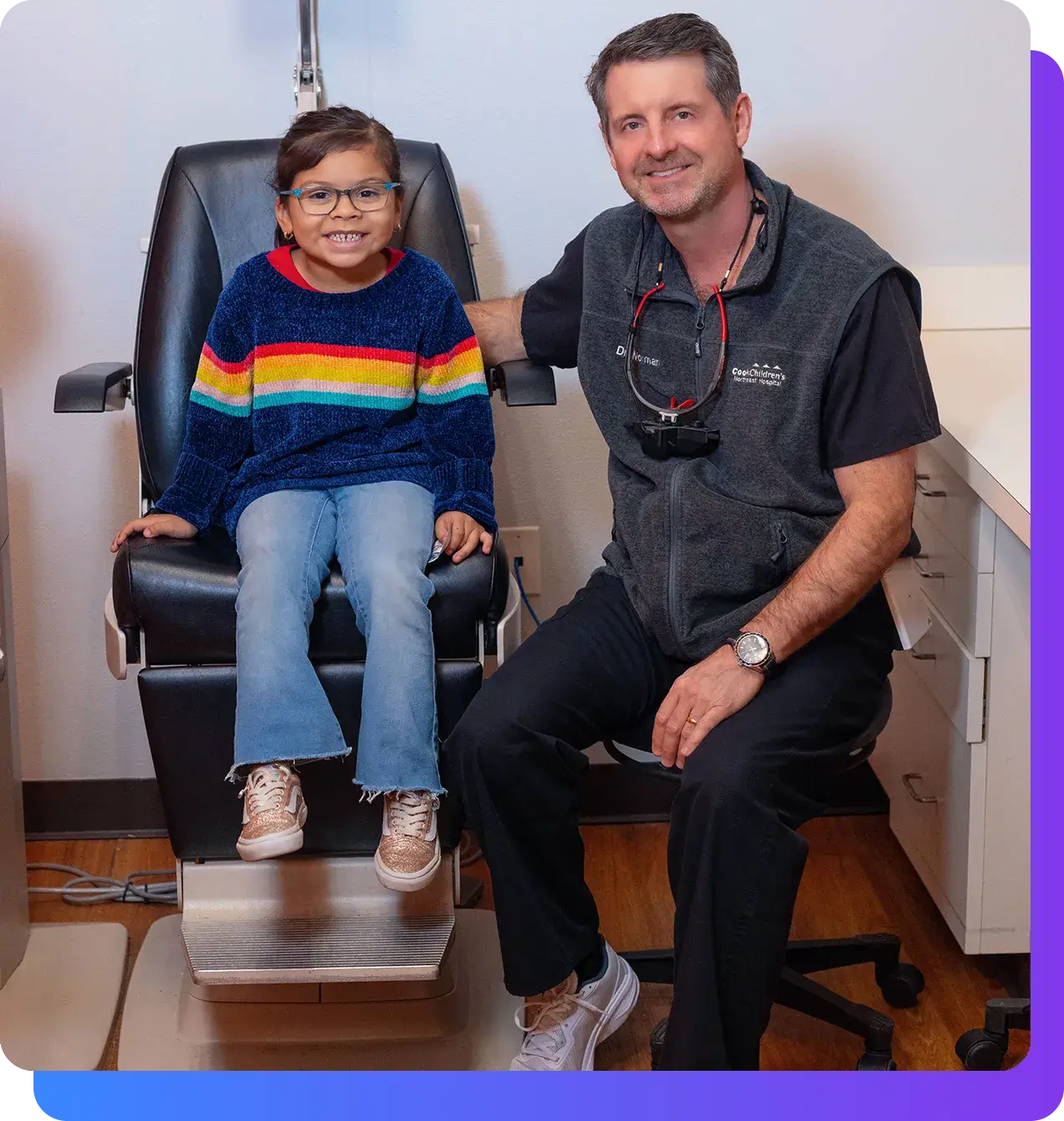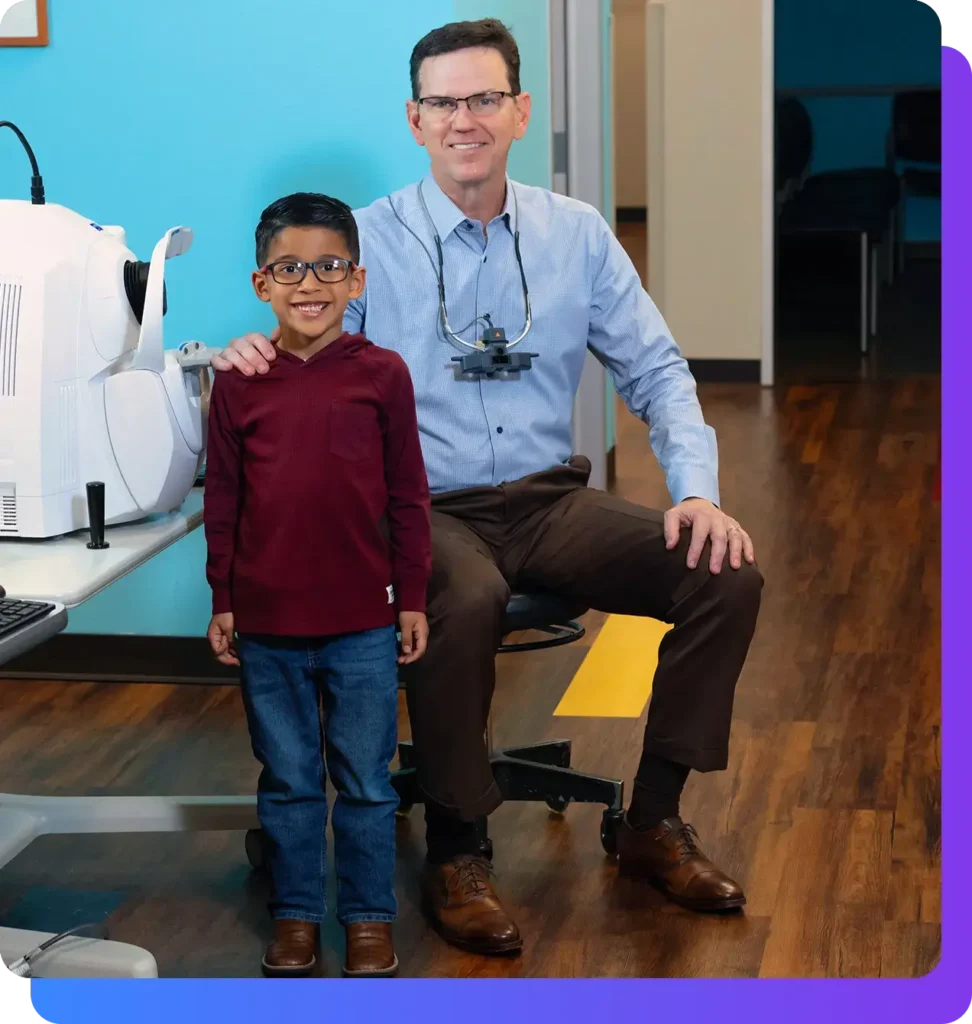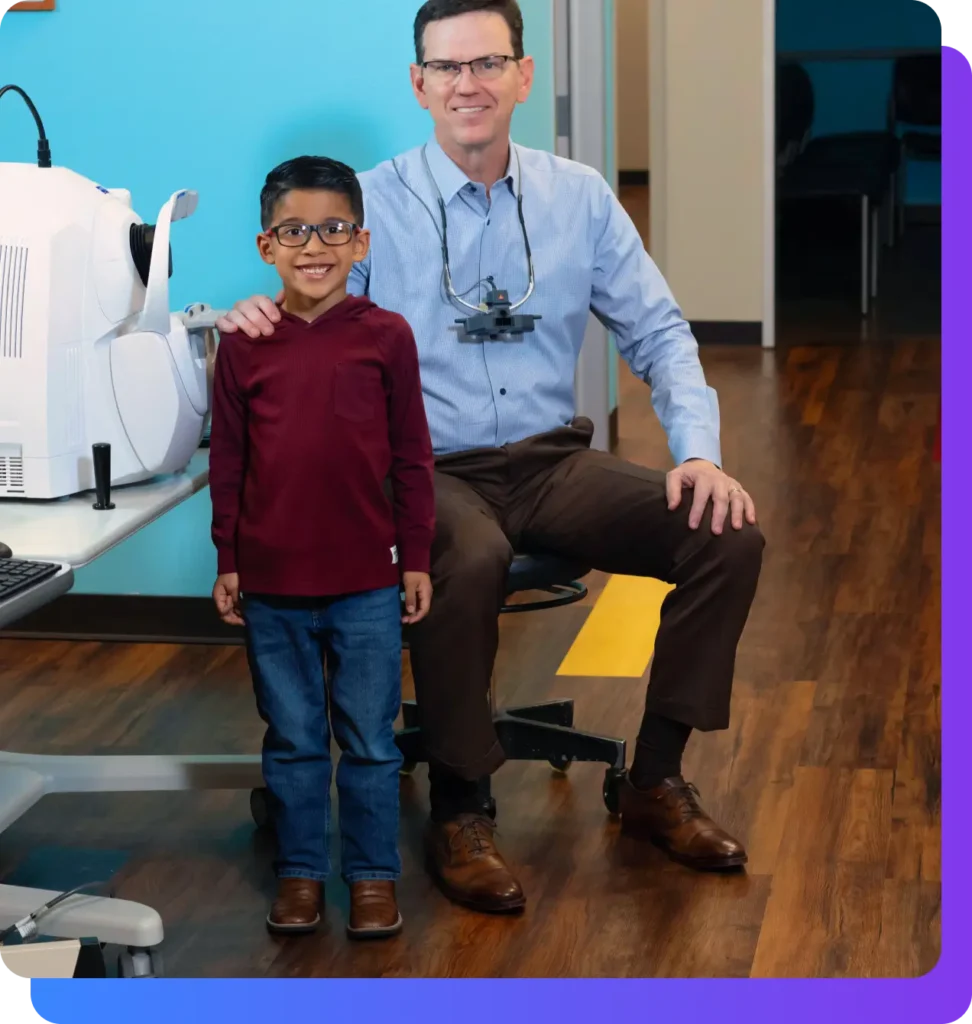Retinopathy of Prematurity
Specialists in North Texas
Discovering that your child may be facing retinopathy of prematurity (ROP) can be an overwhelming and emotional experience for any parent. As a parent, it’s natural to be flooded with concerns about what this diagnosis means for your child’s vision and overall development.
Expert ROP Treatment for North Texas
At Pediatric Eye Specialists, we recognize the depth of your worry and questions you might have about ROP. Our pediatric ophthalmology experts combine medical expertise with compassionate care and are dedicated to guiding you and your child through the complexities of retinopathy of prematurity (ROP). With advanced facilities and an expert understanding of ROP, we transform worry into hope, offering the highest standard of care for the best opportunity at normal vision development.

The Basics: What is Retinopathy of Prematurity?
Retinopathy of prematurity (ROP) is a potentially serious eye disorder affecting premature infants. This condition occurs when abnormal blood vessels grow and spread throughout the retina, the layer of tissue in the back of the eye that senses light and sends images to the brain. These abnormal vessels are fragile and can leak, leading to retinal scarring and detachment, which can result in vision impairment or blindness if not treated. The severity of ROP can vary, with some cases being mild and resolving on their own, while others require medical intervention to prevent vision loss. Early detection and treatment are crucial, typically involving regular eye examinations in at-risk infants, particularly those born very prematurely or with very low birth weight. The prognosis of ROP depends on the severity and the timely application of treatments like Avastin or laser, aimed at preserving vision and promoting normal retinal development.
Why Pediatric Eye Specialists Is Ideal for Treating Retinopathy of Prematurity
The Most Experienced Team in North Texas
With over sixty-five years of collective pediatric ophthalmology expertise, we offer your child unparalleled collaborative care.
Five Convenient Locations
Easily accessible care with offices in Fort Worth, Denton, Southlake, Mansfield, and Prosper.
Unrushed, Clear Communication
We take the time to discuss your child's diagnosis and treatment, ensuring all your questions are answered to ease your concerns.
Affiliated with Cook Children’s Hospital
Our partnership with Cook Children’s Hospital means if your child needs surgery, imaging, or other specialists, they will be treated in one of the nation’s leading pediatric hospitals.
Specialized Expertise
Our expertise means that more optometrists, doctors, and specialists refer their pediatric eye patients to Pediatric Eye Specialists than any other pediatric eye practice in North Texas.
Child and Family Focused
Kids love us, and we love kids! We provide a caring environment for your child and your family.
Advanced Diagnostic Technology
We have the most comprehensive pediatric diagnostic suite in North Texas, allowing for precise diagnosis and highly personalized treatment plans.
Every Child Needs Access to Expert Eye Care
Championing the right to sight, we help navigate insurance, cash pay, and Medicaid options to make superior eye care feasible for all children regardless of their socioeconomic status.

The Benefits of Treating Retinopathy of Prematurity
Addressing retinopathy of prematurity (ROP) early can significantly alter the prognosis for affected infants, emphasizing the importance of prompt and effective treatment.
Success You Can Expect for Your Child
Prevention of Vision Loss
Treating retinopathy of prematurity (ROP) at its early stages can significantly reduce the risk of vision loss, preserving the child's ability to see the world. With timely and effective treatment, the abnormal blood vessel growth can be controlled, reducing the chances of retinal detachment and blindness.
Improved Long-Term Eye Health
Early intervention not only addresses the immediate concerns of ROP but also promotes better long-term eye health. Successful treatment helps ensure that the retina develops more normally, potentially avoiding future eye-related complications.
Access to Advanced Treatment Options
Seeking treatment at Pediatric Eye Specialists provides access to advanced options such as Avastin and laser therapy, which are crucial for managing severe cases of ROP.
Holistic Care for Infant's Development
Treating ROP is not just about saving vision; it's also an integral part of the infant's overall development. Healthy vision plays a critical role in the child's physical, cognitive, and social development.
Emotional Relief for Parents
Knowing that their child is receiving the best possible care for ROP can provide immense emotional relief to parents, alleviating the anxiety and stress associated with the potential of severe vision problems.
Reduction of Complications
Effective treatment of ROP decreases the likelihood of complications like strabismus, amblyopia (lazy eye), or glaucoma, which can arise from untreated cases.
Enhanced Quality of Life
With successful treatment, children are more likely to enjoy a quality of life unhindered by significant visual impairments, allowing them to engage more fully in childhood activities and experiences.
Real Stories,
Real Smiles.
“They were very good with my nonverbal toddler. It was the best doctor visit experience we have had yet. They were awesome, caring, and quick!.”

Amy Glover
Parent of Patient
“Today, Dr. Packwood saved my youngest from a life of blindness and worked a miracle for my family. I cannot express enough gratitude and thanks for their skillful surgery and expertise. 10 of 10 highly recommend.”

Atticus Lee
Parent of Patient
“The staff here is so amazing with my son. We had such a wonderful experience both at the office and for his surgery! I highly recommend Pediatric Eye Specialists!!!!“

Gianna Stutzman
Parent of Patient
“We are so grateful for the genuine care that Dr. Duff provided for our son Lorenzo, which prevented him from going blind! She is truly a gift to the community.“

JS Cocjin
Parent of Patient
“Professional, compassionate, kind and friendly. They took great care of my preemie baby from Day 1 of ROP. Very happy with how my daughter is progressing and has healthy eyes now.”

Suresh K.C.
Parent of Patient
“We’ve seen Dr. Hunt for the past 6 years since my daughter was 9 days old. We have multiple appointments each year and even eye surgery when she was 1. Our experience here has been fantastic every time and we highly recommend this group!.”

Mandy Edmondson
Parent of Patient
“Dr. Norman has always been very attentive and thorough with my daughter, who has Type 1 Diabetes. The staff are warm and always do their best to be accommodating. I highly recommend Dr. Norman.”

Tricia Moon
Parent of Patient
“Absolutely recommend! All around great experience! They made my son feel comfortable during the visit. Treatment was explained, and I walked out with no questions. I loved it. “

Cynthia Valero
Parent of Patient
“Great staff, great doctors; they know how to help ease kids’ fears and provide excellent service. Had to get my little one in same day for an eye injury, and they found a way to make it happen. Would 100% recommend.“

Kris K
Parent of Patient
Start your child’s journey to better vision today.
Embrace a future of clearer vision and confidence for your child. Contact us now to book your consultation at any of our convenient locations across the Metroplex.
Click to Explore Retinopathy of Prematurity
Causes of Retinopathy of Prematurity
Retinopathy of prematurity (ROP) is a complex eye condition affecting premature infants. This section delves into the various factors that contribute to the development of ROP, offering insight into why and how this condition occurs in young infants.
Premature Birth
The primary risk factor for ROP is preterm birth. Infants born before thirty-one weeks of gestation, or those weighing less than 1500 grams (about 3.3 pounds), are at a significantly higher risk. The underdevelopment of the retinal blood vessels in these infants is a key factor leading to ROP.
Oxygen Therapy
While essential for the survival of premature babies, oxygen therapy can contribute to the development of ROP. High levels of oxygen can disrupt the normal development of retinal blood vessels, leading to abnormal growth.
Blood Transfusions
In some cases, blood transfusions, often necessary for the survival of premature infants, have been linked to an increased risk of ROP, possibly due to fluctuations in blood oxygen levels.
Low Birth Weight
Babies with very low birth weight are more susceptible to ROP as their eyes are still in the critical stages of development.
Multiple Births
Twins, triplets, and other multiple births are often born prematurely and with lower birth weights, increasing the likelihood of developing ROP.
Other Health Complications
Infants with severe health issues, including respiratory distress, anemia, gastrointestinal issues and heart problems, are also at a heightened risk of ROP.
Genetic Factors
Research suggests that genetic predisposition may play a role in the susceptibility to ROP, though this area is still under investigation.
By understanding these causative factors, Pediatric Eye Specialists is better equipped to identify infants at risk and monitor them closely for any signs of ROP. Early detection and intervention are crucial in managing this condition effectively and preventing long-term visual impairment.
Understanding these causes is vital for Pediatric Eye Specialists in diagnosing and formulating an effective treatment plan for retinopathy of prematurity.
Types of Retinopathy of Prematurity
Understanding the different stages and severities of retinopathy of prematurity (ROP) is crucial for accurate diagnosis and effective treatment. ROP is classified into various stages based on the extent of abnormal blood vessel development in the retina. This section provides an overview of these classifications, aiding in the comprehension of the condition’s complexity:
Stage 1: Mildly Abnormal Blood Vessel Growth
In this initial stage, there are slight abnormalities in the growth of retinal blood vessels. These changes are typically near the edge of the retina. Often, the condition resolves without treatment at this stage.
Stage 2: Moderately Abnormal Blood Vessel Growth
This stage involves abnormal blood vessel growth that is more pronounced but is still confined to the edges of the retina. Close monitoring is essential to detect progression.
Stage 3: Severely Abnormal Blood Vessel Growth
This critical stage is marked by the growth of abnormal blood vessels toward the center of the eye. These vessels are fragile and may require treatment to prevent retinal detachment and vision loss.
- Plus Disease—A significant indication of severity, plus disease is often associated with Stage 3 ROP. It is characterized by dilation and twisting of blood vessels in the retina, indicating increased blood flow and a higher risk of severe ROP.
Stage 4: Partial Retinal Detachment
- Stage 4A—Partial detachment not involving the macula (the central part of the retina).
- Stage 4B—Partial detachment involving the macula.
Stage 5: Total Retinal Detachment
This is the most severe stage, where the retina is completely detached, leading to severe vision loss or blindness. The retina may have a funnel-shaped appearance.
Aggressive Posterior ROP (AP-ROP)
This less common but severe form of ROP occurs in the most posterior part of the retina. It can progress rapidly and requires immediate attention for treatment.
Pediatric Eye Specialists classifies ROP not just by stage but also by the zone of the retina affected and the extent of plus disease. Understanding these types is crucial for determining the urgency and type of treatment required. Regular and thorough eye examinations are key for early detection and effective management of the various stages of ROP. With proper care and timely intervention, the progression of ROP can often be halted, preventing severe visual impairment.
Signs and Symptoms: Early Detection of Retinopathy of Prematurity
Recognizing the early indicators and associated symptoms of Retinopathy of Prematurity (ROP) is critical for prompt intervention and effective treatment.
In many cases, ROP does not present obvious symptoms to the naked eye, especially in its early stages. This makes regular, comprehensive eye examinations by pediatric ophthalmologists essential for premature infants. Because there are no external signs of a problem, detecting ROP requires a careful and meticulous series of exams until the retina is fully mature. Your neonatologist and pediatric ophthalmologist will ensure timely exams with special care to schedule exams, as appropriate, after discharge from the hospital.
Silent Threats: The Invisible Nature of ROP Symptoms
In many cases, ROP does not present obvious symptoms to the naked eye, especially in its early stages. This makes regular, comprehensive eye examinations by pediatric ophthalmologists essential for premature infants. Because there are no external signs of a problem, detecting ROP requires a careful and meticulous series of exams until the retina is fully mature. Your neonatologist and pediatric ophthalmologist will ensure timely exams with special care to schedule exams, as appropriate, after discharge from the hospital.
Any Premature Infant Should Be Screened for ROP
It is important to understand that all premature infants, particularly those born before thirty-one weeks of gestation or weighing less than 1500 grams (about 3.3 pounds), should have regular eye examinations by a pediatric ophthalmologist experienced in ROP. These screenings are vital for early detection and management of ROP, helping to prevent potential vision loss and ensuring the best possible visual outcomes. Pediatric Eye Specialists screens babies at over twenty hospitals in the region, making them one of the largest providers of this service in the world.
Have Concerns?
These signs and symptoms warrant immediate medical attention. Pediatric Eye Specialists utilizes comprehensive eye examinations, including ophthalmoscopy, to inspect the optic disc and employ neuroimaging techniques like MRI or CT scans for a thorough evaluation. Early detection and intervention are key to managing papilledema effectively and preventing potential long-term effects on a child’s vision and overall health.
Diagnosing Retinopathy of Prematurity: Navigating Through the Diagnostic Process
The diagnosis of Retinopathy of Prematurity (ROP) involves a detailed and careful examination process, primarily focused on screening protocols and advanced imaging techniques. This process is critical in detecting the condition early and accurately to initiate appropriate treatment. Here’s an overview of how Pediatric Eye Specialists approaches the diagnosis of ROP:
Routine Screening Protocols
The first step in diagnosing ROP is routine screening for all premature infants, especially those born before thirty-one weeks of gestation or weighing less than 1500 grams (about 3.3 pounds) at birth. These screenings typically begin a few weeks after birth and continue periodically, as recommended by pediatric ophthalmology guidelines.
Ophthalmoscopic Examination
This fundamental diagnostic tool involves using an indirect ophthalmoscope to visually inspect the interior surface of the eye, including the retina. The examination focuses on identifying any abnormal blood vessel growth and assessing the overall retinal structure.
Pupil Dilation
Before an ophthalmoscopic examination, eye drops are administered to dilate the pupils. This dilation allows a comprehensive view of the retina, including the peripheral areas where ROP commonly begins.
Retinal Imaging
Advanced imaging techniques, such as digital retinal photography or fundus imaging, are employed to capture detailed images of the infant’s retina. These images are crucial for documenting the presence and progression of ROP and aid in planning treatment strategies.
Classification of Disease Severity
ROP is classified based on the location and extent of abnormal blood vessel growth, the presence of retinal detachment, and other retinal changes. This classification helps in determining the severity of the disease and guides treatment decisions.
Use of Specialized Tools
Tools like RetCam, a specialized retinal camera, can be used for more detailed imaging, especially useful in advanced cases or in monitoring the disease over time.
Consultation with Neonatologists
Collaboration with neonatologists and other specialists caring for premature infants is an integral part of the diagnostic process. This multidisciplinary approach ensures a comprehensive understanding of the infant’s overall health and any other factors that may influence ROP.
Pediatric Eye Specialists focuses on early detection and accurate diagnosis of ROP, using the latest technology and adhering to the best practices in pediatric ophthalmology. This careful and detailed approach ensures that infants at risk of or suffering from ROP receive the highest standard of care, paving the way for better visual outcomes.
Treatments for Retinopathy of Prematurity: Comprehensive and Advanced Approaches
The treatment of retinopathy of prematurity (ROP) at Pediatric Eye Specialists is tailored to the specific stage and severity of the disease. Our goal is to preserve and improve vision, employing a range of advanced treatment options:
Anti-VEGF Injections
Anti-Vascular Endothelial Growth Factor (anti-VEGF) injections, such as bevacizumab (Avastin), have become the primary treatment for ROP. These injections are administered into the eye and work by inhibiting the growth factor that leads to the development of abnormal blood vessels. This treatment is particularly useful in severe cases. Multiple treatments may be required.
Laser Therapy
Laser photocoagulation involves the application of laser burns to the peripheral areas of the retina where abnormal blood vessels are present. This procedure helps to stop or reverse the abnormal growth of blood vessels and can prevent retinal detachment.
Surgical Approaches
In severe cases of ROP, particularly those involving retinal detachment, surgical interventions may be necessary. Procedures such as scleral buckling or vitrectomy can help reattach the retina and preserve vision. These surgeries are typically reserved for the most advanced cases of ROP and are performed by our colleagues who specialize in vitreoretinal surgery.
Regular Monitoring and Follow-Up
Continuous monitoring is crucial in the management of ROP. After treatment, infants undergo regular eye examinations to assess the effectiveness of the treatment and to monitor for any recurrence or complications.
Customized Treatment Plans
Every case of ROP is unique, and our treatment plans are customized to the individual needs of each infant. Factors such as the stage of ROP, overall health of the infant, and response to initial treatments are all considered in developing a personalized treatment strategy. At times, we will recommend an immediate treatment plan and, at other times, watchful waiting is the best way forward.
At Pediatric Eye Specialists, we are committed to providing the most effective and advanced treatments for ROP. Our approach combines the latest medical advances with compassionate care, ensuring the best possible outcomes for our youngest patients and their families.
Our commitment at Pediatric Eye Specialists is to provide your child with the highest standard of care, combining medical expertise with compassion and understanding.
Typical Expected Outcomes: Navigating Prognosis and Potential in Retinopathy of Prematurity Treatment
When it comes to retinopathy of prematurity (ROP), the expected outcomes of treatment vary based on the stage of the disease at diagnosis and the response to treatment. At Pediatric Eye Specialists, our approach is grounded in realistic optimism, focusing on maximizing each child’s visual potential while providing clear and honest communication to parents. Here’s what can typically be expected:
Variable Outcomes Based on Severity
The prognosis for ROP largely depends on the severity of the condition at the time of diagnosis. Mild cases of ROP often resolve without the need for treatment, while more severe cases may require intervention to prevent vision loss.
Improvement in Vision
For many infants, especially those treated in the early stages of ROP, there can be a significant improvement in vision. Anti-VEGF injections and laser therapy have been successful in preventing the progression of the disease and preserving vision.
Prevention of Further Progression
A key goal of treatment is to halt the progression of ROP. Successful intervention can prevent the condition from advancing to more severe stages, which can include retinal detachment and severe vision loss.
Continued Monitoring
Even after treatment, infants who have had ROP require continued monitoring. Some children may experience late-onset complications, and ongoing eye examinations are essential for detecting and managing these issues promptly.
Potential for Long-Term Vision Challenges
While treatment can significantly improve outcomes, some children who have had severe ROP may still experience long-term vision challenges, such as nearsightedness, strabismus, or amblyopia.
Importance of Early Detection and Treatment
The earlier ROP is detected and treated, the better the potential outcomes. Early intervention is key to preserving vision and preventing the most severe consequences of the disease.
Individualized Prognosis
Each child’s situation is unique, and the Pediatric Eye Specialists team provides individualized information about prognosis based on the specific circumstances of each case.
Parental Support and Counseling
We understand the emotional impact of a ROP diagnosis and offer counseling and support to families. Our goal is to empower parents with information and support as they navigate their child’s treatment and follow-up care.
In summary, while outcomes for ROP can vary, early detection and treatment typically offer the best chance for a favorable prognosis. Pediatric Eye Specialists is committed to providing comprehensive, compassionate care, guiding families through the treatment process and beyond.
Secure a Brighter Vision for Your Child: Schedule Your ROP Consultation Today
As you navigate the challenges of retinopathy of prematurity, know that you’re not alone. At Pediatric Eye Specialists, we’re committed to guiding you and your child through this journey with expertise, care, and compassion. Early intervention is key to managing ROP effectively, and our team of specialists is equipped with the knowledge and technology to provide the best possible care. Don’t wait to take the crucial step towards securing your child’s visual future. Contact us today to schedule a consultation and embark on a path to safeguarding your child’s vision. Together, we can aim for the brightest outcomes.

Start your child’s journey to better vision today.
Embrace a future of clearer vision and confidence for your child. Contact us now to book your consultation at any of our convenient locations across the Metroplex.
How does the length of time spent in the neonatal intensive care unit (NICU) affect the risk of developing retinopathy of prematurity?
Parents often ask about the connection between the duration of a NICU stay and the likelihood of their child developing ROP. The risk can increase with longer NICU stays, especially for extremely premature infants or those with complex medical conditions.
Can dietary or nutritional factors influence the development or progression of retinopathy of prematurity?
Certain nutritional factors, particularly for premature infants, are crucial. Studies suggest that a diet rich in certain nutrients can support eye health, but it’s not a direct preventive measure against ROP.
Are there any long-term nonvisual complications associated with retinopathy of prematurity?
Beyond vision, parents are concerned about other long-term impacts of ROP. While primarily an eye condition, severe cases of ROP can sometimes be associated with other developmental delays due to the underlying causes of prematurity.
How do genetic factors play a role in retinopathy of prematurity?
Currently, there’s no conclusive evidence to suggest a strong genetic link, as ROP is more closely related to premature birth and the subsequent need for intensive neonatal care.
If my child has mild ROP, what are the chances of it resolving without intervention?
Parents with children diagnosed with mild ROP frequently ask about the likelihood of spontaneous resolution. Many mild cases do resolve on their own, but careful monitoring is essential to ensure the condition does not progress to more severe stages requiring treatment.
How can an infection during pregnancy or childbirth affect the risk of retinopathy of prematurity in my child?
Infections during pregnancy can lead to inflammation and vasodilation (changes in blood flow) within the mother’s body and potentially affect the developing fetus. If these changes impact the blood vessels in the developing eye, they could contribute to conditions like retinopathy of prematurity.
Does retinopathy of prematurity affect the brain’s visual perception in any way?
Yes, retinopathy of prematurity can affect the visual perception processed by the brain. This condition primarily affects the retina, the light-sensitive layer at the back of the human eye, but since the retina is directly connected to the brain, any damage or impairment can influence how visual information is perceived.
Can retinopathy of prematurity lead to issues with the vitreous body of the eye?
Retinopathy of prematurity can sometimes lead to complications that affect the vitreous body, such as bleeding or the formation of scar tissue. These complications might require intervention by an eye surgeon through procedures like vitrectomy.
Are there any drugs used to treat retinopathy of prematurity, or is eye surgery the only option?
While eye surgery, such as laser surgery, can be used in the treatment for retinopathy of prematurity, anti-VEGF drugs have become the first-line therapy. Anti-VEGF drugs can be injected to help slow or stop abnormal blood vessel growth in the eye, which is a hallmark of this eye disease.
What symptoms should I watch for that might indicate my child is experiencing complications from retinopathy of prematurity?
Parents should watch for signs of bleeding in the eye, changes in the eye’s appearance, or any indication of visual impairment. If your child exhibits unusual behaviors such as excessively rubbing their eyes, squinting, or shortness of breath, it’s essential to consult a healthcare provider. These symptoms could indicate high levels of stress or discomfort, which may be associated with the progression of the condition.